by Scott Hawbaker
| After World War II, the Erie began to update their Automatic Block Signaling (ABS) system to Centralized Traffic Control (CTC) to handle the increased traffic after the war. Many of the fifty year old semaphores around Buffalo were replaced with "modern" Color Light Signals (CLS) of different styles from both Union Switch and Signal (US&S) or General Railway Signal (GRS). These new signals had very few if any moving parts and were much easier to maintain than the old semaphores. Today many of these "new" signals are well over 50 years old and time has taken its toll. All over the United States, these veterans are being replaced with 21st century versions of the CLS from many manufacturers. 2006 marked the end of an era with the replacement of the Erie Street three. |
| After a lot of grinding and sandblasting I found that a few other areas would need replacement metal as well. A local metal fabricator cut me four 36" strips of mild steel and I began to make my patches. |
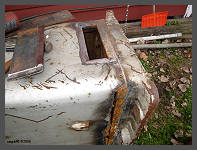 |
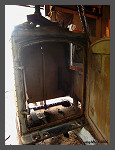 |
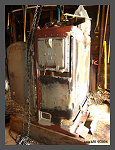 |
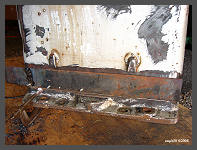 |
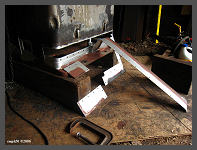 |
| The US&S R2 three unit head assembly is what really identifies this style of signal. Each light is composed of a glass 8 3/8" clear outer lens (doublet) and a colored 5 1/2" glass inner doublet. Behind the inner lens is a precision 10 volt 18 watt incandescent bulb. This combination creates a pencil thin beam that can be seen for miles. The head, door, lens rings and upper/lower brackets are also all cast iron adding another 180 pounds to the signal. I was able to remove all the 10-32 brass machine screws with minimal problems and only had to replace six of them! The three steel bracket mounting "U Bolts" needed to be "chased" with a 3/4" die and I re-tapped all the 10-32 holes. After wire brushing and some sandblasting I was ready to repeat the prime and paint process on the 18 pieces for the head. On the Erie Railroad, everything above the maintenance platform was painted flat black to prevent headlight reflection but the platform on down recieved the aluminum paint. The Pennsy and NYC gave their entire signal the flat black treatment. |
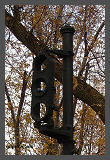 |
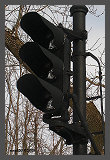 |
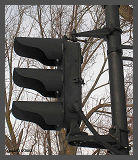 |
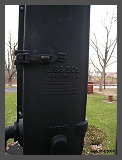 |
| Taking advantage of one of the nicer fall weekends, I dug four 8 by 30 inch deep holes for the concrete needed to hold the 1" mounting bolts. I welded up four "J" Bolt assemblies using double 1" nuts that I would be able to screw the mounting studs down into. It took six 80 pound bags redi-mix to fill the four holes but I got lucky and they all lined up with the base pattern I had cut. |
| The back door of the head went up the ladder next to prevent any rain from getting in and messing things up. The old "oakum rope" seal of the door was still in good shape and closed up tightly with a few twists of the locking door hasp. |
Web Site Hosting by TRAIN WEB
The WNYRHS, Inc. P.O. Box 416, Buffalo, NY. 14231-0416 is an independent organization and has no affiliation with any other local or national group.
The Society is a fully qualified organization under 501 (C) (3) of the Internal Revenue Code and all donations to the Society are tax deductible.
©Copyright 1999 - 2017 WNYRHS Inc. all rights reserved